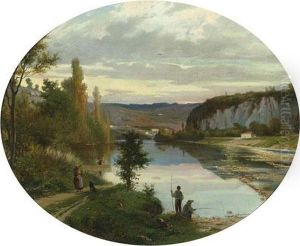Louis Auguste Lombard Paintings
Louis Auguste Lombard, a French painter born in 1825, played a significant role in the 19th-century European art world. His contributions, primarily in portraiture and historical scenes, reflect the academic art tradition of his time. Lombard's work is characterized by its meticulous attention to detail, vibrant color palette, and the emotional depth of his subjects. Despite the prominence of Romanticism and later Impressionism during his lifetime, Lombard's style remained deeply rooted in the Neoclassical and Romantic traditions, emphasizing beauty, precision, and a harmonious composition.
Lombard's education in art began at a young age, influenced by the rich cultural atmosphere of France. He studied under prominent artists of the period, which honed his skills in both drawing and painting. His talent was recognized early in his career, earning him accolades and commissions from notable figures within French society. Throughout his career, Lombard exhibited his work at various prestigious venues, including the Paris Salon, where his pieces received critical acclaim. His portraits, often of high-profile individuals, were especially celebrated for their elegance and lifelike quality.
Despite his success, Lombard's life was not without challenges. The political and social upheavals of 19th-century France, including the revolutions of 1848 and the Franco-Prussian War, impacted the art world and Lombard's career. However, he continued to work and contribute to the artistic community until his death in 1875. Lombard's legacy is preserved in the collections of French museums and in the admiration of art historians who recognize his skill in capturing the human spirit and the complexities of his time. His dedication to the academic style, even as the art world around him evolved, marks him as a significant figure in the history of French painting.

